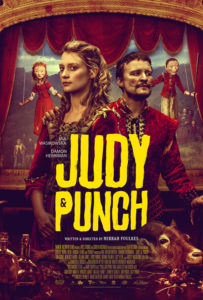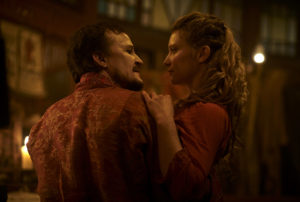Film Review: “Judy & Punch” Gives the Classic Puppet Show a Proper Feminist Twist
Written by: Christopher Llewellyn Reed | June 4th, 2020

Judy & Punch (Mirrah Foulkes, 2019) 3 out of 4 stars.
The classic “Punch and Judy” puppet show of years gone by, now unfamiliar to most members of our youngest generations, is something I vaguely remember from my own youth. I have a French mother and grew up spending a lot of time in my maternal land, where the spectacle was still popular in public parks; oddly so, given the violence and misogyny on display, with Punch beating wife Judy and others with a large stick. Then again, are Tom & Jerry cartoons and their ilk any less intense in their rendering of comic savagery? However one feels about the appropriateness of it all, most of us have early on been exposed to these glorifications of callous mayhem, and though some works may last centuries, eventually they fade.
Now Australian writer/director Mirrah Foulkes (also an actress, though not here), making her feature debut, brings back Punch and Judy, but as the title indicates, with a twist. The focus this time is on Judy, who goes through an extensive amount of pain and suffering before emerging on top. More than just a feminist retelling of this past-its-prime tale of male privilege, Judy & Punch embraces those disenfranchised for other reasons, too. Set in a fictionalized 17th-century European-Australian hybrid dystopia, the film packs its polemic inside an engaging drama of tragedy and revenge. Though not without structural fissures, the movie mostly works, led by a gripping performance from the ever-reliable Mia Wasikowska (Damsel) as Judy.

When first we meet her, she is playing right-hand helpmate to Punch (Damon Herriman, The Nightingale), a bit of a drunken ne’er-do-well who is nevertheless a fine marionette artist … when sober. In this opening scene, he is very much so, though we sense that it is Judy whose calm and no-less-creative presence moves things along in perfect harmony. This is the town of Seaside, nowhere near the sea; the name, along with many other characters and moments, harkens back to the source material, and this is a reference to where Punch & Judy shows were often performed, in seaside carnivals. Our entry into the theater comes via a mysterious child making her way through the darkened streets. Where she comes from will become relevant later.
Soon, the already faltering marriage, propped up by Judy’s refusal to see Punch for who he is and the fact that they have a baby together, takes a sudden turn for the macabre worse, and Judy is discarded and left very much for dead in the nearby woods shunned by the townspeople for harboring strange outcasts and witches. Re-enter the furtive girl from the opening scene, who finds Judy’s body and brings her to the encampment of “witches,” who promptly revive the not-quite-deceased Judy and set her on the path to recovery. As she gets better, she plots vengeance, and not just against Punch, but against all of Seaside and the bigotry that has sent those who do not conform into exile. Expect violence and retribution, without the comedy.

It’s a very satisfying narrative, though some of the incidental characters are a bit broadly written for my taste, and some turning points too obvious. Well photographed and designed, the film has a marvelously strange-yet-familiar visual aesthetic that suits the reappropriation of a well-worn, sexist story. As always, Wasikowska shines, and Herriman manages to make an unpalatable character approach three dimensions. This Judy delivers a powerful punch.

